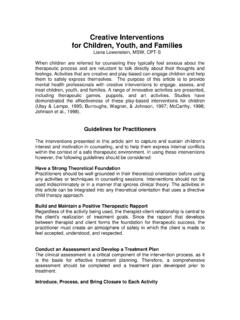Transcription of Extended Play-Based Developmental Assessments …
1 Extended Play-Based Developmental Assessments Clinicians guide Eliana Gil, Multicultural Clinical Center Springfield, Virginia with Narkia Green, Virginia Polytechnic Institute and State University 1. Introduction Problem Statement Abused children are often reticent to volunteer information about traumatic experiences. In addition, young children may find it difficult to perceive events accurately, conceptualize their meaning, and explain them verbally. Self-reporting is further compromised by emotions children may feel (associated with stressful experiences), such as fear, confusion, worry, loyalty, conflicts, and anxiety.
2 Many abused children are also routinely interviewed by multiple professionals (within rigid timeframes), which may further confuse, exhaust, or frighten young children. Purpose of Extended Play-Based Developmental assessment The purpose of the Extended Play-Based Developmental assessment (EPBDA) is to give children an opportunity to externalize their thoughts and feelings in the context of a less demanding, user-friendly environment that allows and encourages children to express themselves utilizing both verbal and non-verbal communication.
3 Description Extended Play-Based Developmental Assessments are designed to determine children's overall functioning; identify current clinical symptoms; identify trauma impact, if any; assess children's perceptions of parental support and guidance; and determine children's perceptions of their internal and external resources. Clinicians who conduct EPBDA observe and address a variety of domains including physical functioning, patterns of relational interactions, thematic material in their play , and externalized concerns.
4 A variety of directive and non-directive techniques are utilized avoiding suggestive language or questioning and allowing children to feel comfortable enough to volunteer relevant information about their world. Non-directive approaches are based on the relational experience between the clinician and the child. Children are able to control session activities and decision making and change is left with them. Clinicians provide an unconditional acceptance of children rather than a symptom-focused assessment .
5 In addition, clinicians provide non-judgment and reflection, as well as respect and empathy to children. There are many benefits to children through the use of a non-directive approach, such as allowing them to externalize their internal worlds, placing few demands or expectations on them, and allowing them to engage at their own pace. In addition, EPBDA tend to be less threatening to most children and views them as individuals with unique interests and needs. When conducting EPBDA, clinicians observe and interpret the child's play in order to understand their internal experience.
6 Equally important is the recognition that play has many curative benefits and children can utilize it in a reparative way. These Assessments are conducted in play therapy offices that have a range of therapeutic toys. In play Therapy: The Art of the Relationship, Landreth (2002) provides a list containing a wide range of items therapists should incorporate into a play therapy room (See Appendix D). Sweeny (2003) and Sweeney & Homeyer (1999) suggest that play materials in general should: 2. - Facilitate a wide range of creative expression - Facilitate a wide range of emotional expression - Engage children's interests - Facilitate expressive and exploratory play - Allow exploration and expression without verbalization - Allow success without prescribed structure - Allow for non-committal play - Have sturdy construction for active use Schaefer (1993) proposes eight curative aspects of play that are important to the needs of children which provide the following opportunities.
7 - Developmental growth and learning - Mastery and control - Decrease of anxiety through affective discharge - Release of endorphins and promotion of well-being - Release of pent up conditions - Communication and externalization of inner world - Symbolic (conscious or unconscious) working through - Helping children assimilate stressful experiences shrinks the problem 3. Rationale for Extended Assessments 1. Children's natural medium is play . As stated earlier, children's natural mode of communication is not necessarily verbal language.
8 More often than not, children express themselves through a range of behaviors, non-verbal communication, and symbolic language (stories, art, play movement, etc). It is important for clinicians to broaden their repertoire to include an interest and comfort with more ample interactions with children. 2. Children may have had multiple interviews. Children who have been sexually abused may have already been interviewed by various professionals such as Child Protective Services workers, police officers, attorneys, or parents.
9 Parental interviews can often be problematic in that parents who have concerns about their children's safety may ask questions in a way that frighten or worry children. Professional interviews may be problematic in that professionals may feel uncertain or uncomfortable interviewing very young children and thus the interviews may feel stressful to both interviewer and interviewee. 3. Children in crisis may be anxious, confused, distrustful, and fearful. When children have been hurt in any way they may already be scared or disoriented.
10 It is more difficult for children to meet new people and answer personal questions when they already feel unsafe or unsettled. 4. Often children who are referred for Assessments may have been placed in foster care. They may have talked to different helpers, and may feel uncertain about the stability of professionals in their lives. This can cause situations of mistrust and fear. 5. Children deserve time to gain comfort. Children who are referred for Assessments deserve the opportunity to become comfortable in new settings, including therapy offices.

